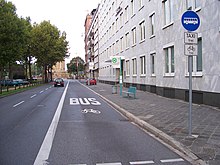Bus lane: Difference between revisions
m Added external link to Aus bus industry |
|||
| Line 47: | Line 47: | ||
[[fi:Linja-autokaista]] |
[[fi:Linja-autokaista]] |
||
[[zh:公車專用道]] |
[[zh:公車專用道]] |
||
==References== |
|||
*[http://www.ozebus.com.au Buses in Australia - includes useful industry resources] |
|||
Revision as of 00:54, 6 February 2008


A bus lane or bus only lane is a lane on a road restricted to buses, and generally used to speed up public transport otherwise held up by traffic congestions. Often taxicabs, high occupancy vehicles or motorcycles[1] and bicycles may use the bus lane as well (though these uses can be controversial, as they can reduce the capacity of the bus lane for its main function). Bus lanes are a central part of bus rapid transit measures.
Function
The aim of a bus lane is to give priority to buses and save journey time in places where roads are congested with other traffic. A bus lane is not necessarily very long, as it may only be used to 'detour' a single congestion point such as an intersection. However, some cities have built large stretches of bus lanes which in some places amount to a separate local road system, often called a busway system.
Bus lanes are normally created when the road in question is both likely to be congested as well as heavily traveled by bus routes. Entire roads can be designated as bus lanes (such as Oxford Street in London), allowing only buses, taxis and delivery vehicles, or a contra-flow bus lane can allow buses to travel in the opposite direction to other vehicles.[2] Some bus lanes operate on certain times of the day only, usually during rush-hour, allowing all vehicles at other times, and it is common to have bus lanes in only one direction (such as for the main direction of the morning rush hour traffic, with the buses using normal lanes in the other direction).
Sometimes, bus lanes receive different set of traffic signals as well.
History
According to the American Public Transportation Association (APTA)[3] and the National Transit Database (NTD),[4] the world's first designated bus lane was created in Chicago in 1939.
The first bus lanes in Europe were established in 1962 in the German city of Hamburg.[citation needed] Other large German cities soon followed, and the implementation of bus lanes was officially sanctioned in the German highway code in 1971. Many experts from other countries (among one of the first, Japan) studied the German example and then went forth to implement similar solutions in their own countries. For example, two years later (on January 15, 1964) the first bus lane in France was designated along the quai du Louvre in Paris and the first counter-flow lane was established on the old pont de l’Alma on June 15, 1966.[5] On 26 February 1968, the first bus lane in London was put into service on Vauxhall Bridge.[citation needed] By 1972, there were over 140 km of with-flow bus lanes located in 100 cities within OECD member countries, and the network was found to be growing substantially in the following decades.[6]
The El Monte Busway between El Monte and Downtown Los Angeles was the first busway in the USA, constructed in 1974.[7]
Criticism
The installation of bus lanes requires additional space to either be constructed (increasing the impact of the road on the surrounding area, and possibly requiring private land)[8] or taken from existing lanes (thus reducing the capacity of the road for private vehicles). The latter is especially controversial with many road users when this is actually an ancillary reason (i.e. when local authorities want to explicitly combine improved public transport options with reducing or at least not improving convenience for motorists).[9]
They can also become inefficient if weak traffic enforcement encourages illegal parking on them (for example in shopping areas). The bus then has to merge back into traffic, which may be totally stopped, causing substantial schedule delays.[citation needed] They are also often used by vehicles not authorised, which reduces their capacity for the intended purpose.[10]
See also
References
- ^ The Use of Bus Lanes by Motorcycles (from Traffic Advisory Leaflet 2/07, Department for Transport, United Kingdom)
- ^ The Highway Code (See: "Signs Giving Orders". From the United Kingdom Highway Code. Retrieved 2008-01-10.)
- ^ Milestones in U.S. Public Transportation History (from the APTA website. Retrieved 2007-12-06.)
- ^ History of the NTD and Transit in the US (from the NTD website. Retrieved 2007-12-06.)
- ^ Les zones bleues et les couloirs pour autobus (from the AMTUIR website, Musée des Transports Urbains. Retrieved 2007-12-06.Template:Fr icon)
- ^ Assessing travel time impacts of measures to enhance bus operations - Jepson, D.; Ferreira, L., Road & Transport Research, December 1999. Retrieved 2007-12-06.)
- ^ Los Angeles (from the San Francisco Metropolitan Transportation Commission website. Retrieved 2007-12-06.)
- ^ Transport plan will force homes and businesses to move - The New Zealand Herald, Monday 12 March 2007
- ^ Get moving: Bus access, safety mean no end to rush-hour hassle - The New Zealand Herald, Tuesday 1 May 2007
- ^ 1779 cheats spotted in single morning using bus lanes - The New Zealand Herald, Tuesday 3 October 2006
